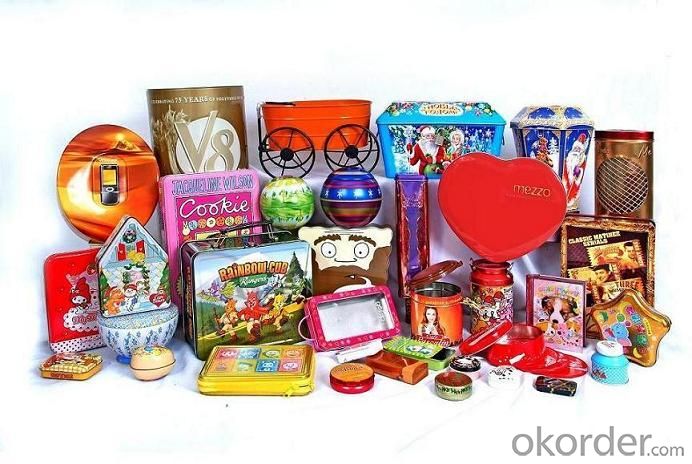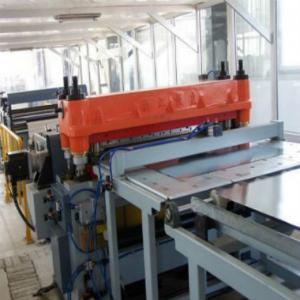Tinplate for Paint Drums, Prime Grade/Secondary Grade
- Loading Port:
- China main port
- Payment Terms:
- TT OR LC
- Min Order Qty:
- 25 m.t
- Supply Capability:
- 40000 m.t/month
OKorder Service Pledge
OKorder Financial Service
You Might Also Like
Specification
1.Usage
Tinplate is widely used for making all types of containers, containing industrial usage such as paint can, oil can, aerosol cans etc., and food cans like milk powder cans, tomato paste can, dry food cans etc.
2. Specification
standard: GB/T2520, JIS G3303, DIN EN10202
Material: MR /SPCC
Thickness available: 0.16-0.50MM
Width available: 600~1050MM
Temper grade: T1 – DR8
Tin coating: ordinary 2.8g/2.8g, 5.6g/5.6g and others
Package: sea worthy export package.
Applications: Tin can for chemicals & paint cans, industrial cans, food cans
3. Our CA Line Production Range
Temper | Thickness(mm) | Width(mm) | Length(mm) |
T3CA | 0.19~0.20 | 800~900 | 520~1068 |
0.21~0.25 | 800~950 | ||
0.26~0.45 | 800~1050 | ||
T4CA | 0.17~0.20 | 800~950 | |
0.20~0.45 | 800~1050 | ||
T5CA | 0.17~0.20 | 800~950 | |
0.20~0.28 | 800~1050 |
4. Our factory photo & equipments

5. FAQ
a. what’s your company name?
our company named CNBM international corporation, we are both one large state owned company and tinplate supplier in China
b. where your mill situated?
Our head office is in Beijing, while our mill in Hebei province.
c. how about the delivery time?
usually 55~65 days after receipt advance payment or original LC;
d. what payment term you accept?
Our payment term is very feasible, such as TT, DP, LC at sight, LC after sight etc.
e. can you offer MTC?
Of course, we will issue MTC after each shipment, for customer reference and testing if some quality issue appears.
- Q: Can tinplate be used for packaging tobacco products?
- Yes, tinplate can be used for packaging tobacco products. Tinplate is a commonly used material for packaging various products, including tobacco products, due to its durability, resistance to corrosion, and ability to maintain product freshness and quality.
- Q: What are the chemical resistance properties of tinplate?
- Tinplate exhibits excellent chemical resistance properties, making it highly resistant to corrosion and oxidation. It can withstand exposure to various chemicals, acids, and alkalis without deteriorating or reacting with them, making it a preferred choice for packaging and coating applications in the food and beverage industry.
- Q: How is tinplate protected during transportation and storage?
- Tinplate is typically protected during transportation and storage through various measures such as applying a protective coating, using appropriate packaging materials, and implementing suitable handling and stacking procedures. The protective coating, often a thin layer of oil or lacquer, helps to prevent corrosion and maintain the integrity of the tinplate. Additionally, packaging materials like plastic wraps, paper interleaves, or cardboard dividers are used to separate and cushion the tinplate sheets, preventing scratches, dents, or other damages. Proper handling techniques, including careful loading and unloading, as well as appropriate stacking methods, ensure that the tinplate remains stable and secure during transportation and storage, reducing the likelihood of any physical harm.
- Q: How does tinplate compare to plastic packaging?
- Tinplate packaging offers several advantages over plastic packaging. Firstly, tinplate is more durable and can withstand higher temperatures, making it suitable for preserving food and beverages. It also provides better protection against external factors such as sunlight, moisture, and oxygen, thus ensuring the longevity and quality of the contents. Additionally, tinplate is fully recyclable and has a higher recycling rate compared to plastic, making it a more sustainable choice. Lastly, tinplate packaging has a premium appearance that can enhance the product's perceived value and appeal to consumers.
- Q: How does tinplate contribute to the overall sustainability of the supply chain?
- Tinplate contributes to the overall sustainability of the supply chain in several ways. Firstly, it is a highly recyclable material, which means that it can be reused multiple times without compromising its quality. This reduces the need for virgin materials and minimizes waste generation. Secondly, tinplate has excellent barrier properties, protecting the contents of the packaging from external factors such as light, moisture, and oxygen, thus reducing food waste and extending shelf life. Additionally, tinplate is lightweight yet sturdy, enabling efficient transportation and reducing carbon emissions during shipping. Overall, tinplate's recyclability, protective properties, and transportation efficiency make it a sustainable choice in the supply chain.
- Q: Can tinplate packaging be used for aerosol products?
- Yes, tinplate packaging can be used for aerosol products. Tinplate is a commonly used material for aerosol cans due to its durability and ability to withstand the pressure exerted by aerosol products. Additionally, tinplate provides a barrier against moisture and other external factors, ensuring the quality and safety of the aerosol contents.
- Q: How does tinplate contribute to the sterility of medical equipment?
- Tinplate contributes to the sterility of medical equipment by providing a protective barrier that prevents the growth of bacteria and other microorganisms. The tin coating on the steel surface of the tinplate acts as a barrier against moisture and oxygen, preventing rusting and corrosion. This not only maintains the integrity of the equipment but also ensures that no contaminants are introduced into the medical environment. Additionally, tinplate is easy to clean and sterilize, further enhancing its contribution to the sterility of medical equipment.
- Q: What's the head iron?
- The name "tinplate", also known as tin plated iron, is the common name for tin plated steel sheet. The English abbreviation for "SPTE" refers to cold-rolled low carbon steel sheet or strip coated with commercially pure tin on both sides. Tin plays a major role in preventing corrosion and rusting. It will be the steel strength and formability and corrosion resistance of tin soldering, and beautiful appearance with a material, corrosion resistant, non-toxic, high strength and good ductility properties.
- Q: What are the main factors influencing the supply of tinplate?
- The main factors influencing the supply of tinplate are the availability and cost of raw materials such as tin, steel, and other alloys, the production capacity and efficiency of tinplate manufacturers, government regulations and policies, fluctuations in demand from industries such as packaging, automotive, and electronics, and global economic conditions and trade dynamics.
- Q: What are the different methods of printing on tinplate?
- There are various methods used for printing on tinplate, including lithography, screen printing, and digital printing. Lithography involves transferring an image onto a metal plate, which is then inked and pressed onto the tinplate. Screen printing utilizes a mesh stencil to transfer ink onto the tinplate. Digital printing, on the other hand, involves directly printing the desired image onto the tinplate using specialized printers. These methods offer versatility and allow for the creation of high-quality designs on tinplate for various applications.
Send your message to us
Tinplate for Paint Drums, Prime Grade/Secondary Grade
- Loading Port:
- China main port
- Payment Terms:
- TT OR LC
- Min Order Qty:
- 25 m.t
- Supply Capability:
- 40000 m.t/month
OKorder Service Pledge
OKorder Financial Service
Similar products
Hot products
Hot Searches
Related keywords




























